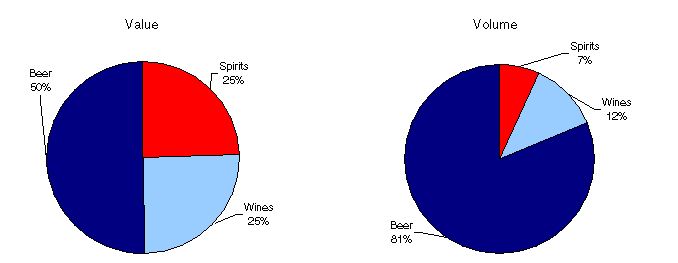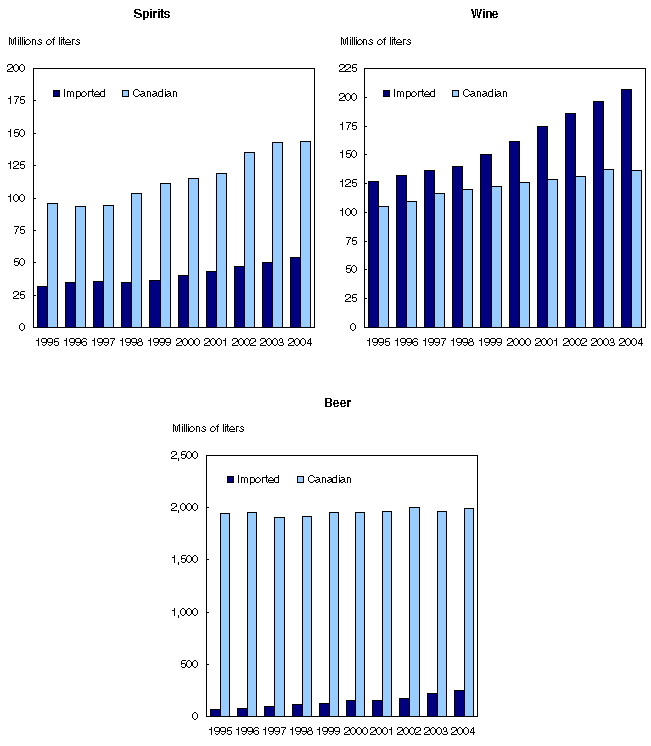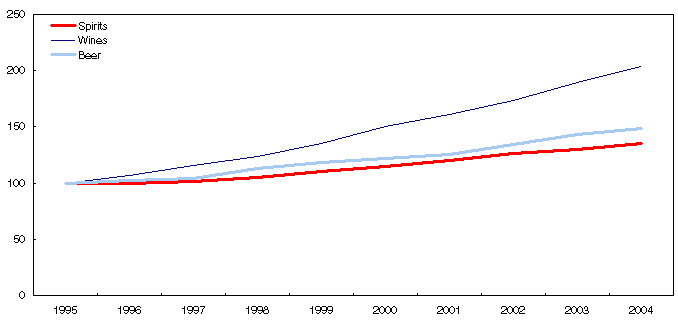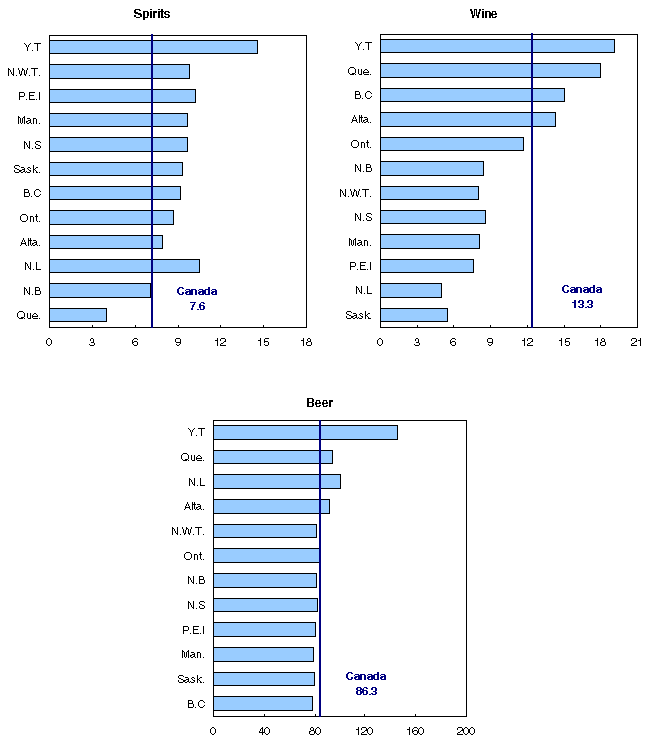
















 |
|
 |                |
Information identified as archived is provided for reference, research or recordkeeping purposes. It is not subject to the Government of Canada Web Standards and has not been altered or updated since it was archived. Please "contact us" to request a format other than those available.
| The control and sale of alcoholic beverages in Canada
2004 Analysis Canadians increased their purchases of beer, wine and spirits last year, but the rate of growth cooled somewhat, according to new data on sales. In total, Canada’s beer and liquor stores and agencies sold more than $16.1 billion worth of alcoholic beverages during the fiscal year ending March 31, 2004, up 4.9% from the year before. This rate of growth was slower than the 6.0% increase during the previous fiscal year. As usual, beer was by far the most popular beverage. In terms of dollar value, beer captured 50.7% of sales, spirits, 24.7%; and wine 24.6%. Chart 1

Although Canadian products are still dominant in the beer market, imported beer is gaining ground. In 2003/2004, volume of sales of imported beer captured 11% of the Canadian market, up from 10.2% in the previous fiscal year and less than 3% a decade ago. In the wine market, red wine was by far the preferred choice of Canadians. Red varieties accounted for 49% of the volume of sales, while white brands had only 36% and unidentified wine 15%. Revenue from the sale of alcoholic beverages plus the net income realized by provincial and territorial liquor authorities hit $4.3 billion in 2003/2004, up 7.2% from the previous year. This was the largest year-over-year increase in the last 20 years. Provincially, net income increased most in British Columbia (+11.1%) and in Ontario (+9.4%). Text table 1
Chart 2

The provinces: what Canadians like to buy Stores and agencies sold almost 2.8 billion litres of alcoholic beverages in 2003/2004. Beer accounted for 80.5% of sales, wine 12.4% and spirits, 7.1%. On average, each Canadian aged 15 and older purchased 107.2 litres of alcoholic beverages, up slightly from 106.2 litres during the previous fiscal year. Of this total, Canadians bought 86.3 litres of beer, 13.3 litres of wine and 7.6 litres of spirits during the year. Their total per capita purchases of alcoholic beverages amounted to $623.60. Among provinces, consumers in Quebec and Newfoundland and Labrador led the pack, purchasing a high of just over 115 litres of alcoholic beverages per capita. In contrast, those in Saskatchewan purchased only 94.4 litres, lowest of all. In volume, per capita purchases of beer were also highest in Newfoundland and Labrador and Quebec, and lowest in British Columbia. Newfoundlanders also bought the highest per capita volumes in spirits. Quebeckers led the way with purchases of wine. Per capita sales of wine, in volume, were above the national average in only three provinces: Quebec, Alberta and British Columbia. Red wine was the preferred choice in only four provinces: Quebec, where it accounted for almost 70% of the market compared with white; and Manitoba, Alberta and British Columbia, where it represented about 55% of the market. Among spirits, rum was still most popular in Newfoundland and Labrador, Prince Edward Island and Nova Scotia. Whisky was the preferred choice for consumers from Ontario to British Columbia. Text table 2
Chart 3

Volume sales of domestic beverages rising more slowly than imported brands During the past 10 years, volume sales of domestic alcoholic beverages have increased at much lower rates than imported products. From 1993/1994 to 2003/2004, volume sales of Canadian spirits increased at an annual average rate of 4.0% compared with an average of 6.1% for imported products. The contrast is even bigger in the beer market. During this 10-year period, the volume of imported beer sales more than quadrupled compared with a gain of only 3.1% for Canadian products. In the wine market, the volume of sales of Canadian wine usually exceeded that of imported wine up to the fiscal year 1989/1990. Since then, however, the Canadian wine market has been dominated by imported products. For red wine, imported products have captured three-quarters of the Canadian market, while imported brands account for about one-half of the white wine market. Beer: Sales surpass $8-billion mark Beer sales surpassed the $8-billion mark in 2003/2004. In total, beer and liquor stores and agencies sold almost $8.2 billion worth of beer, up 4.0% from the previous year. On a per capita basis, this amounted to $316.20 for every person aged 15 and over. Consumers bought $1.1 billion in imported beer, up 13.5% from the previous year. In contrast, sales of domestic brands rose 2.7% to $7.1 billion. Text table 3
Chart 4

Canada exported 391 million litres of beer in 2003/2004, while it imported 220 million litres. During the past decade, the volume of imported beer has increased at an annual average rate of 14.7%, compared with only 1.7% on average for our exports to the world. More than 60% of all imported beer distributed on the Canadian market comes from the United States, Netherlands and Mexico. All of our exported beer went to the United States. Wine: Market dominated by imports Liquor stores and their agencies sold nearly $4.0 billion worth of wines in 2003/2004, up 7.4% from the previous year. Value of sales of imported red wines rose 9.7% in 2003/2004, compared with a 6.5% gain among domestic red wines. Between 1993/1994 and 2003/2004, imports of wine increased at an annual average rate of 6.0% to 285 million litres. More than 60% of all imported wine distributed in Canada came mainly from three countries: France, Italy and the United States. On the other hand, 85% of our export of wines went to the United States in 2003/2004. Spirits: Whisky top seller Liquor stores sold nearly $4.0 billion worth of spirits in 2003/2004, up 4.3% from the previous year. Sales of imported spirits climbed 6.5% to $1.4 billion, while sales of domestic spirits grew 3.1% to $2.6 billion. Among Canadian products, whisky was the top seller, followed by rum and vodka. The leading imported product was liqueurs. In the spirits market, based on litres of absolute alcohol, Canada imported 33 million litres of spirits in 2003/2004, an annual average gain of 5.0% from a decade earlier. American products accounted for more than 30% of all imported products, followed by those from the United Kingdom, at 21.5%. Text table 4
|
||||||||||||||||||||||||||||||||||||||||||||||||||||||||||||||||||||||||||||||||||||||||||||||||||||||||||||||||||||||||||||||||||||||||||||||||||||||||||||||||||||||||||||||||||||||||||||||||||||||||||||||||||||||||||||||||||||||||||||||||||||||||||||||||||||||||||||||||||||||||||||||||||||||||||||||||||||||||||||||||||||||||||||||||||||||||||||||||||||||||||||||||||||||||||||||||||||||||||||||||||||||||||||||||||||||||||||||||||||||||||||||||||||||||||||||||||||||||||||||||||||||||||||||||||||||||||||||||||||||||||||||||||||||||||||||||||||||||||||||||||||||||||||||||||||||||||||||||||||||||||||||||||||||||||||||||||||||||||||||||||||
|
|
|